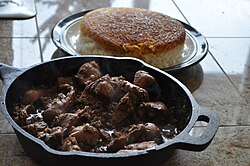 A bowl of chicken fesenjān, with Persian rice topped by
tahdig | |
| Type | Stew |
|---|---|
| Course | Main course |
| Place of origin | |
| Region or state | Northern Iran ( Gilan) |
| Associated cuisine | |
| Created by | Iranians ( Gilaks, Talysh) |
| Main ingredients | Pomegranate juice, walnuts, poultry ( duck or chicken) |
| Variations | Lamb meatballs |
Fesenjān ( Persian: فسنجان; also called fesenjoon in Tehrani dialect) is a sweet and sour Iranian stew (a khoresh) from Northern Iran. It is typically served over rice in the Iranian manner. [1] Like other khoresh stews served over rice, fesenjan is common also to Iraqi cuisine. [2] As a festive dish for special occasions, it has become part of Jewish Rosh Hashannah celebrations. Even though the typology of Jewish ethnic cuisines is imprecise. [3] In Azerbaijan, where it called fisincan plov, the stew is made with lamb meatballs instead of poultry. [4]
About
Fesenjān is flavored with pomegranate paste and ground walnuts (see bazha) [5] and spices like turmeric, cinnamon, orange peel, cardamom, and rosebud. [6] It is traditionally made with eggplant and poultry ( duck or chicken). [6] Fesenjān can also be made using balls of ground meat or chunks of lamb. Depending on the recipe, it can have a sweet or sour taste. Fesenjān is served with Iranian white or yellow rice ( polo or chelo).
If the pomegranate sauce comes out too sour, sugar and fried onions may be added to sweeten it. [7] Sometimes, a hot iron is applied to cause oxidation and darken the sauce's color. [7]
It is a dish that is part of the dinner table on Yaldā Night celebrations. [5]
History
The earliest known reference to fesenjān is in Mirza Ali-Akbar Khan Ashpazbashi's Sofra-ye at'ema from 1881, which lists ten different varieties of the dish: walnut (today the most common), almond, eggplant, kidney bean, quince, potato, carrot, pumpkin, fish, and yogurt. [7] The first dictionary to mention fesenjān is the Farhang-e Anandraj, which calls it fasūjan and says that the dish originated in Gilan. [7]
Culture
Fesenjān is an elaborate dish that is often reserved for special occasions. [7] It is considered "a rich man's dish", which is referenced in the Persian expression "he behaves as if he has had partridge and fesenjān", meaning to show off or act pretentiously. [7]
In the traditional Iranian system of garm and sard foods (i.e. "hot" and "cold", respectively), fesenjān is considered "hot" because it uses walnuts, which are also considered a "hot" food. [7] In order to balance out this hotness, sometimes people will add coriander (a "cold" plant) to it; peeled pumpkin is also added for the same reason, as well as to act as a sugar substitute. [7]
See also
References
- ^ Anderson, E.N. (30 April 2018). Asian Cuisines: Food Culture from East Asia to Turkey and Afghanistan. Berkshire Publishing Group. p. 99. ISBN 9781614728467.
- ^ Amanat, Abbas; Vejdan, Farzin, eds. (2012). Iran Facing Others: Identity Boundaries in a Historical Perspective. Palgrave Macmillan.
- ^ The Oxford Handbook of the Jewish Diaspora, Oxford University Press, 2021, p. 683
- ^ Fisincan Plov Nasıl Yapılır? - Can Azerbaycan - TRT Avaz (in Azerbaijani).
- ^
a
b Miers, Thomasina (2017-12-15).
"Thomasina Miers' recipe for roast winter vegetables with walnut and pomegranate sauce". the Guardian. Retrieved 2018-07-26.
Richly sweet, subtly sour, with a satisfying depth of flavour from ground walnuts: fesenjan is a tempting Persian stew traditionally eaten during the winter solstice.
- ^ a b Davidson, Alan (2014). Jaine, Tom (ed.). The Oxford Companion to Food (3 ed.). Oxford University Press. p. 48. ISBN 978-0199677337.
- ^ a b c d e f g h Elahi, Etrat. "FESANJĀN". Encyclopaedia Iranica. Retrieved 6 March 2022.
External links
- Azerbaijani cuisine
- Iranian stews
- Afghan cuisine
- Iranian cuisine
- Rosh Hashanah foods
- Sephardi Jewish cuisine
- Talysh cuisine
- Turkish stews
- Poultry dishes
- Walnut dishes
- Azerbaijani cuisine stubs
- Middle Eastern cuisine stubs
- Iran culture stubs
- Asian cuisine stubs
- Afghanistan stubs
- Turkish cuisine stubs